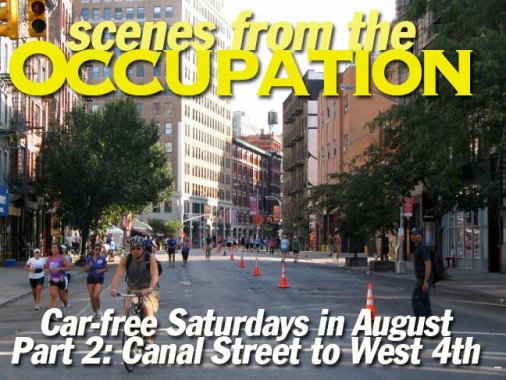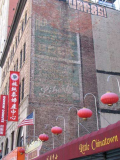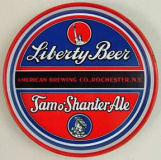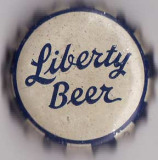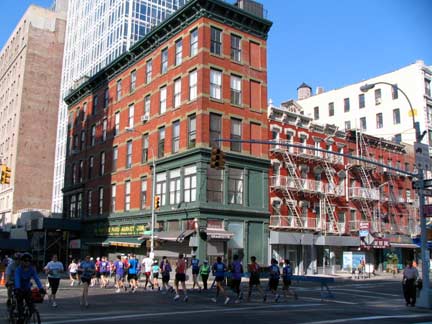On the first three Saturdays in August the Department of Transportation shuts down Lafayette Street, 4th Avenue, Park Avenue South, Park Avenue and part of West 72nd Street in theSummer Streets program, designed to give New Yorkers the run of these streets without threat of auto traffic. It’s been a smashing success after its 2009 institution, though the program is geared toward bicyclists and runners; plodding pedestrians like your webmaster are still largely relegated to the sidewalk, mostly by necessity. On August 7, 2010 I decided to walk the route and give the event a ForgottenNY spin.
This ancient wall dog ad for a beer distributor has held forth on Lafayette and Canal Streets for decades. The Liberty brand is prominent at the bottom of the ad. I found photos of Liberty Beer bottlecaps and coasters online. I don’t think the present Anchor Brewing brand Liberty Ale has anything to do with the old brand.
Howard Street, looking toward Centre. The street extends west to Crosby.
The 1880s hang on at the corner of Lafayette and Grand as modernity looms behind.
I hope the floors of this building at the NW corner of Grand and Lafayatte are unoccupied. Otherwise, the light is kept out by two gigantic liquor ads.
The recently renovated (they weren’t quite finished in 2010) Lt. Joseph Petrosino Park at the triangle formed by Lafayette, Kenmare and Cleveland Place. It was named for a pioneering anti-Mafia detective in the early 20th Century:
When he joined the Police Department in 1883, Petrosino was the city’s shortest officer, at five feet and three inches tall. Police Commissioner Theodore Roosevelt personally promoted him to Sergeant of Detectives in 1895. While investigating anarchists in the United States, Petrosino warned President McKinley of threats against his life; however, the warning was not heeded and the President was assassinated in 1901.
Within ten years, Petrosino was named lieutenant and given command of the new Italian Squad, a unit created to combat the crime organization known as the Black Hand. Under his leadership, several thousand arrests were made, and more than 500 offenders were sent to prison. Crimes against Italian-Americans dropped by fifty percent. Petrosino was killed while on assignment to Palermo, Sicily.
When his body was returned to New York, thousands of mourners formed a funeral procession which marched from Little Italy to Calvary Cemetery in Queens. Lt. Petrosino was the only New York police officer who had died in the line of duty outside the United States. The park named in his honor is located just north of the Renaissance Revival edifice at 240 Centre Street, which served as Police Headquarters from 1910 to 1971. NYC Parks
[In 2011, after a renovation from 2008-2010, Petrosino Park was closed off again for yet another one.]
More on Joseph Petrosino by the ever-informative William Bryk.
Kenmare Street is another relatively new street on the Manhattan map. It’s a western extension of Delancey Street from the Bowery to Lafayette that was laid out early in the 20th Century. Local politician and labor leader “Big Tim” Sullivan had it named for the county in Ireland where his mother was born. ABOVE: the new Andre Balazs development, 210 Lafayette aka One Kenmore Square, has an undulating exterior, a common factor in early 21st century architecture. BELOW: The La Esquina Corner Deli and the La Esquina Mexican restaurant occupy a former diner on Kenmare east of Lafayette.
Lafayette Street looking north at 9 AM Saturday, August 7.
The famed Puck Building takes up the entire block between Lafayette, Mulberry, the alley Jersey Street and East Houston. It was built as a printing plant between 1886 and 1893 by the publishers of the satirical magazinepublished between 1877 and 1918. It has recently been home to both the New York Press weekly and Spy monthly, though neither are there anymore. Some of the Puck Building was shaved off when Lafayette Street was extended south. In the bad old days before 1993, Lafayette and Houston was bum window washer central.
The landmarked Colonnade Row (LaGrange Terrace) on today’s Lafayette Street was built in 1833 (on the much shorter and exclusive Lafayette Place) by architect Seth Geer and originally consisted of nine houses, of which only four remain today. When first built the houses were occupied by social bright lights of the era such as the Astors and Vanderbilts. Since its plummy days, Colonnade Row has been allowed to chip, molt and deteriorate into a fabulous ruin. Blue Man Group took over a basement space in 1991 and have gradually become a worldwide phenomenon.
The whereabouts of the five missing Colonnade Row buildings had been a mystery, after John Wanamaker, the Philly department store king, bought them and had them demolished in the first decade of the 20th Century. It was thought the missing columns and facades were lost forever. It turns out that they have been on the grounds of the Delbarton School, run by St. Mary’s Abbey in Morristown, NJ, for many years.
Page completed August 11, 2010
PART 1 | PART 2 | PART 3 | PART 4 | PART 5 | PART 6 | PART 7
